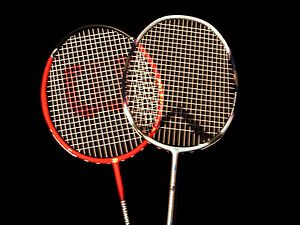|
|
|---|
Tuesday, October 5, 2010

Danish badminton player Peter Gade
Badminton and it's playing style
This article is about the sport. For other uses, see Badminton (disambiguation).
| Highest governing body | Badminton World Federation |
|---|---|
| First played | 17th century |
| Characteristics | |
| Contact | No |
| Team members | Single or doubles |
| Categorization | Racquet sport |
| Equipment | Shuttlecock |
| Olympic | 1992-present |
The shuttlecock (or shuttle) is a feathered projectile whose unique aerodynamic properties cause it to fly differently from the balls used in most racquet sports; in particular, the feathers create much higher drag, causing the shuttlecock to decelerate more rapidly than a ball. Shuttlecocks have a much higher top speed, when compared to other racquet sports. Because shuttlecock flight is affected by wind, competitive badminton is played indoors. Badminton is also played outdoors as a casual recreational activity, often as a garden or beach game.
Since 1992, badminton has been an Olympic sport with five events: men's and women's singles, men's and women's doubles, and mixed doubles, in which each pair consists of a man and a woman. At high levels of play, the sport demands excellent fitness: players require aerobic stamina, agility, strength, speed and precision. It is also a technical sport, requiring good motor coordination and the development of sophisticated racquet movements.
Laws
The following information is a simplified summary of the Laws, not a complete reproduction. The definitive source of the Laws is the BWF Statutes publication, although the digital distribution of the Laws contains poor reproductions of the diagrams.Playing court dimensions-

Badminton court, isometric view
The full width of the court is 6.1 metres (20 ft), and in singles this width is reduced to 5.18 metres (17 ft). The full length of the court is 13.4 metres (44 ft). The service courts are marked by a centre line dividing the width of the court, by a short service line at a distance of 1.98 metres (6 ft 6 inch) from the net, and by the outer side and back boundaries. In doubles, the service court is also marked by a long service line, which is 0.76 metres (2 ft 6 inch) from the back boundary.
The net is 1.55 metres (5 ft 1 inch) high at the edges and 1.524 metres (5 ft) high in the centre. The net posts are placed over the doubles sidelines, even when singles is played.
The minimum height for the ceiling above the court is not mentioned in the Laws of Badminton. Nonetheless, a badminton court will not be suitable if the ceiling is likely to be hit on a high serve.
Equipment laws-
The Laws specify which equipment may be used. In particular, the Laws restrict the design and size of racquets and shuttlecocks. The Laws also provide for testing a shuttlecock for the correct speed:
- 3.1
- To test a shuttlecock, use a full underhand stroke which makes contact with the shuttlecock over the back boundary line. The shuttlecock shall be hit at an upward angle and in a direction parallel to the side lines.
- 3.2
- A shuttlecock of the correct speed will land not less than 530 mm and not more than 990 mm short of the other back boundary line.
Equipment-

Badminton racquets
Racquets-
Badminton racquets are light, with top quality racquets weighing between 75 and 95 grams (2.6 to 3.3 ounces) including the strings. They are composed of many different materials ranging from carbon fibre composite (graphite reinforced plastic) to solid steel, which may be augmented by a variety of materials. Carbon fibre has an excellent strength to weight ratio, is stiff, and gives excellent kinetic energy transfer. Before the adoption of carbon fibre composite, racquets were made of light metals such as aluminium. Earlier still, racquets were made of wood. Cheap racquets are still often made of metals such as steel, but wooden racquets are no longer manufactured for the ordinary market, because of their excessive mass and cost. Nowadays, nanomaterials such as fullerene and carbon nanotubes are added to rackets giving them greater durability.There is a wide variety of racquet designs, although the laws limit the racquet size and shape. Different racquets have playing characteristics that appeal to different players. The traditional oval head shape is still available, but an isometric head shape is increasingly common in new racquets.
Strings-
Badminton strings are thin, high performing strings in the range of about 0.62 to 0.73 mm thickness. Thicker strings are more durable, but many players prefer the feel of thinner strings. String tension is normally in the range of 80 to 160 N (18 to 36 lbf). Recreational players generally string at lower tensions than professionals, typically between 18 and 25 lbf (110 N). Professionals string between about 25 and 36 lbf (160 N).It is often argued that high string tensions improve control, whereas low string tensions increase power. The arguments for this generally rely on crude mechanical reasoning, such as claiming that a lower tension string bed is more bouncy and therefore provides more power. This is in fact incorrect, for a higher string tension can cause the shuttle to slide off the racquet and hence make it harder to hit a shot accurately. An alternative view suggests that the optimum tension for power depends on the player: the faster and more accurately a player can swing their racquet, the higher the tension for maximum power. Neither view has been subjected to a rigorous mechanical analysis, nor is there clear evidence in favour of one or the other. The most effective way for a player to find a good string tension is to experiment.
Grip-
The choice of grip allows a player to increase the thickness of his racquet handle and choose a comfortable surface to hold. A player may build up the handle with one or several grips before applying the final layer.Players may choose between a variety of grip materials. The most common choices are PU synthetic grips or towelling grips. Grip choice is a matter of personal preference. Players often find that sweat becomes a problem; in this case, a drying agent may be applied to the grip or hands, sweatbands may be used, the player may choose another grip material or change his grip more frequently.
There are two main types of grip: replacement grips and overgrips. Replacement grips are thicker, and are often used to increase the size of the handle. Overgrips are thinner (less than 1 mm), and are often used as the final layer. Many players, however, prefer to use replacement grips as the final layer. Towelling grips are always replacement grips. Replacement grips have an adhesive backing, whereas overgrips have only a small patch of adhesive at the start of the tape and must be applied under tension; overgrips are more convenient for players who change grips frequently, because they may be removed more rapidly without damaging the underlying material.

A shuttlecock with a plastic skirt
Shuttlecock-
A shuttlecock (often abbreviated to shuttle) is a high-drag projectile, with an open conical shape: the cone is formed from sixteen overlapping feathers embedded into a rounded cork base. The cork is covered with thin leather or synthetic material.Synthetic shuttles are often used by recreational players to reduce their costs as feathered shuttles break easily. These nylon shuttles may be constructed with either natural cork or synthetic foam base, and a plastic skirt.
Additionally, nylon shuttlecocks come in three varieties, each variety for a different range of temperatures. These three varieties are known as green (slow speed which will give you an extra 40% hang time/shot length), blue (middle speed), and red (fast speed). The colours, and therefore speeds, are indicated by coloured strips fastened around the cork. In colder temperatures, a faster shuttle is used, and in hotter climates, a slower one is chosen.
Shoes-
Badminton shoes are lightweight with soles of rubber or similar high-grip, non-marking materials.Compared to running shoes, badminton shoes have little lateral support. High levels of lateral support are useful for activities where lateral motion is undesirable and unexpected. Badminton, however, requires powerful lateral movements. A highly built-up lateral support will not be able to protect the foot in badminton; instead, it will encourage catastrophic collapse at the point where the shoe's support fails, and the player's ankles are not ready for the sudden loading, which can cause sprains. For this reason, players should choose badminton shoes rather than general trainers or running shoes, because proper badminton shoes will have a very thin sole, lower a person's centre of gravity, and therefore result in fewer injuries. Players should also ensure that they learn safe and proper footwork, with the knee and foot in alignment on all lunges. This is not only a safety concern, as proper footwork is critical in order to move effectively around the court.
Mitsubishi Motors Badminton Horse Trials Friday 30th April -Monday 3rd May 2010 - Official Site The World's Greatest 3-Day-Event - Buy Tickets, Get Results,
NEW DELHI: India's new badminton star Saina Nehwal led the home country closer to a Commonwealth Games quarter-final place in the team event with their. Badminton involves the use of a 5 foot net, lightweight rackets, and a shuttlecock. It can be played by individuals or paired teams either indoors.
From Wikipedia-
Labels: picture and it's news for all., vedio
0 Comments:
Subscribe to:
Post Comments (Atom)
















